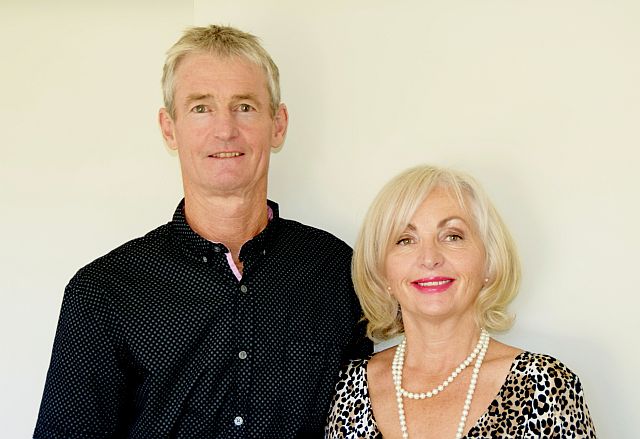How to Choose a Massage Table
Please note, that there are a lot of different ways to manufacture many different types of massage tables, so I use terms such as “generally” and “usually”. This entire help page is my opinion and observations, based on over 27 years in the New Zealand massage industry, as a massage therapist, table manufacturer, and later, also as an importer.
You can also ring us if you would like things verbally explained, we are more than happy to do this. Phone 09 832 3137 and ask for Graeme Wright or Suzanne Mackenzie.
Points to consider when purchasing a massage table and an example below, of why it's important to choose carefully from a supplier who knows what it takes to make a reliable table.
I am a first-time buyer to Just Tables whose service, knowledge and customer care are a breath of fresh air especially as I made a poor decision and purchased a new table from a TradeMe shop. The photograph of that table and specs seemed fine. Oh, my goodness what a disaster when the flimsy, misaligned and worse still extremely squeaky table arrived. Then came the fun of returning the item to a dirty, fully locked down warehouse in the back of beyond which seemed to be a car yard. Eventually, the grumpy, seller who had been hiding was "smoked" out by me. An unpleasant experience I could easily have avoided if I had chosen to use Just Tables at the outset.
1) Do you want a table for home use, professional use, or semi-professional use (e.g. part time work from home)?
Is it heavy massage? (e.g. sports massage or deep tissue work), Beauty Therapy, or one of the many “healing therapies” such as Reiki, etc.
The purpose (or the type of therapy) you are using the table for is an important point to consider, because obviously, the wear and tear structurally on your massage table, is far greater with sports massage, than for a Reiki healing session. In sports massage, there is a lot of body movement, with a lot of weight behind the movements. In Reiki, there is no movement of the client’s body on the table by the therapist.
Consider also, that for “home use”; the table may be used 2 or 3 times a week, or maybe 2 or 3 times a month. At the other end of the scale, a professional may use the table 6 to 8 hours a day, 4 to 7 days a week. This professional may use the equivalent of 20 years “home use”, in 1 year. His/her table needs to be far more durable than a table that will still give many years of “home use”.
2) Price Consideration. As with purchasing any product, you generally get what you pay for. A poor quality massage table can look the same as a good quality massage table, especially when purchasing via the Internet. There can be many differences in the quality and durability of the individual components that are used in the massage table’s construction. Also, the construction methods can be key to how long the table will last. Much "cheaper" tables may last a professional only a short time, depending on the type of usage. They will last longer for "home use" because they are not used as much. Consider that there are some key areas, that if the table fails in, means that it will not be economically viable to repair. Your initial purchase price will be wasted money.
The best thing for you to do to ensure you get a good massage table for your purpose; is to research the options. Time spent doing this may mean the difference between being happy with your purchase, and having regrets.
It is very important to enquire as to the availability of spare parts, and comprehensive after-sales service, should you need maintenance or repair work. A massage table that needs parts or repair and is out of warranty is no good to you if your supplier has no backup service.
For your information. We have been heavily involved with our Chinese manufacturers to ensure that their tables meet our own high standards as a New Zealand massage table manufacturer for over 27 years, with an excellent reputation for quality. Critical areas such as foam density, plywood thickness and sturdiness, along with other construction methods and materials, have been addressed to ensure the durability and longevity of our massage tables.
3) The Weight of the table. This is the physical weight of the massage table. Portable tables range in weight from about 10kgs to about 20kgs. Tables under 13kgs are quite light to handle, 14 and 15kgs is still quite a good weight to handle, 16 to 17kgs is starting to get heavier, and weights up from there are starting to get quite heavy for the average person. You need to consider whether you will be transporting the table a lot, (eg mobile massage therapist), and also how big and strong you are. Be aware that a table with an adjustable backrest built into it is heavier than a two-piece (normal, flat, no backrest table). Backrest tables are normally a bit longer than a two-piece table also. Do not get a backrest table unless your modality requires it, (eg Beauty Therapy, Reflexology, Tattoo Tables etc), or if you do not need to move the table much.
4) Static weight. Note that any table can support a lot of weight. (I have seen photos of portable tables with over 1000kgs of bags of cement stacked on them.) In table information, this is called static weight. If you pushed hard and sideways on a table with 1000kgs of weight on it, it would most likely collapse, so, while this is interesting information, it is not a great help to you in your purchasing decision.
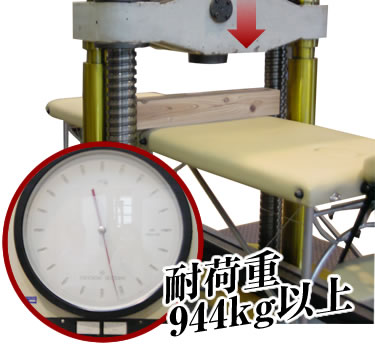
5) Working weight is another term used in information on tables. This usually means that the table is rated for the weight of the therapist and the client. (e.g. a 70kg therapist + an 80kg client = working weight of 150kgs.) A large amount of the massage therapists weight can be transferred through the client's body onto the massage table. This working weight is really just a guide as to how robust the manufacturer thinks their table is. The real test of a table is how durably the table is constructed. See “Point loading and plywood thickness” (in the below information). Also, how much sideways and end to end “wracking” movements (that therapies like massage place on a table), can the table withstand, and for how long?
6) Point loading and plywood thickness. This is a very common problem with imported massage tables. This is where a large client, getting on or off the table, puts a lot of weight on their knee or elbow. By putting a lot of their weight (e.g. a 110kg client) in a small area, (a few square centimetres), the weight on the plywood table top is very high in that small area. This may lead to a break/split in the plywood table top. Although imported table plywood quality has improved over recent years, I have seen many competitors tables with broken plywood because of this “point loading”. It is “fixable”, but with the low cost of tables, and a large amount of time taken to fix the broken plywood problem, it is usually not worth it financially, to have the table repaired. This problem of broken plywood has come about with the advent of cheaper table imports to New Zealand.
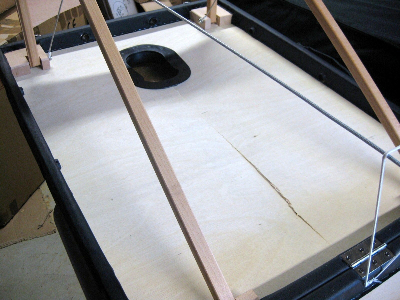
This “point loading/plywood thickness” problem is very important to consider. You may purchase a cheaper table that may be adequate for your purposes. If you are unlucky and have the plywood “point loaded”, either by a big person, or a smaller person slipping accidentally, it may break. If this happens, it will almost certainly not be worth it financially to have it repaired. Your original purchase price will have been wasted.
7) Table dimensions. Most new portable tables tend to be 700mm wide. This is a good width for most uses. It is not too narrow, which makes keeping client arms on the table easier (years ago most tables were 600mm to 650mm wide), and yet not too wide for you as the therapist (the wider the table, the more you need to lean over to reach your client).
Most portable tables tend to be about 1.85m long for a massage table and 1.92m to 1.95m long for a beauty therapy table (one with a backrest incorporated into the table) These lengths suit most purposes. Non-portable tables tend to be about 2.0m long and a variety of widths.
8) Foam density. Foam is rated by its density. Density means the amount of foam material used per cubic metre of finished foam product. Foam is expensive and is a reasonably big component of the total material cost of manufacturing a table. This means that manufacturers may be using lower density foams to save costs. The lower density foam is cheaper to produce but also means there is less material in it to provide cushioning. Generally speaking, lower density foams do not last as long as higher density foams and are prone to "collapsing" (does not bounce back up). Also remember that all foam will lose approximately 20% of its cushioning in the first few months of use. This is normal. Ideally, a table with foam that feels a little too firm to start with, will be ideal in a few months time and will tend to last longer. Foam quality can also vary. Is the foam manufactured to a high and consistent standard, and so meets the standards that it is said to conform to?
See in the photo below, the line across the table where the foam has started to collapse, which has allowed the foam to shift under the vinyl.
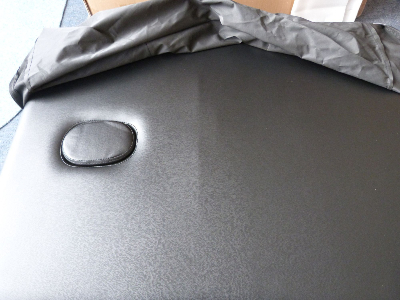
Portable tables foam can range from 20kg per cubic metre (sometimes less) to about 28kg, and thicknesses from 25mm to 50mm.
For portable massage tables, I would recommend a minimum of 40mm foam thickness (50mm is better) and a minimum of 24kg per cubic metre for home use, and 50mm foam thickness at 28kgs per cubic metre for semi-professional or professional table use.
For your information. We use a 28kg density foam for better cushioning and longer life on all our portable table models. We have successfully used this 28kg density rated foam for over 25 years with good results and good customer feedback.
Non-portable tables tend to have foam densities of 20kg per cubic metre to 40kg, and varying thicknesses of 40mm to 75mm. Non-portable tables usually have a thick one-piece table top, which is very rigid, and so requires thicker and denser foam cushioning (compared to a portable table), to be comfortable to lie on. Portable tables with plywood tops do flex and bend, so do not require quite as much cushioning.
For a non-portable table, I would recommend about 50mm of foam thickness at about 38kg per cubic metre density.
For your information. All our stationary tables have a 50mm 38 kg foam density for good comfort and very long life. We use this foam on all our non-portable tables because they are usually used in high usage, high impact clinic situations. Non-portable Tables: Click here for more information.
9) Vinyl quality. This can vary a lot. Better quality vinyl tends to stand up to oils better than poor quality, but remember that oils are not good for vinyl. (Oils do lead to vinyl cracking). See “Tips on use and care of your table”
PVC vinyl is used to cover the majority of massage tables. It is strong, durable and waterproof. Massage oil and your bodies own oils can be cleaned off the surface with relative ease.
PU leather is used to cover some tables. PU leather is not leather. It is made synthetically. It does have a nice, soft feel to it, but it is no more resistant to oils and water than PVC vinyl. In care and use, it is the same as for PVC vinyl.
You need to be able to trust that your supplier has sufficient experience in the industry to be sourcing a good quality vinyl for their tables, as a poor quality vinyl may not be apparent until after your guarantee has run out.
10) Squeaking and cracking noises in a table. It is possible for all portable tables to “squeak”, as they all have many pivot points in the legs and stays. You may also get some cracking noises from the plywood table top (normally, any cracking noises from the plywood will occur in the first few times of using a new table). While it does not occur with all tables, it is not unheard of. These noises are not necessarily detrimental to the performance of the table, however, in some cases, excessive and continuing noises, are probably an indication that there is a problem, that needs to be repaired before it is too late, and your table breaks.
If an older table is making noise, it may also be an indication of a problem.
If there are noises coming from your existing table, get someone to move about on your table, while you listen and observe the underside of the table (but not from directly underneath the table if you think there is any chance of the table collapsing). It may then be possible to see or hear the problem area. If in doubt, speak to a competent professional in the industry.
Most problems are repairable. It just comes down to whether this is economically viable when taking into account the tables $ value. Bear in mind all the pivoting points in the legs and stays in a portable table. These points wear, and can also be the source of the noise. I have got rid of noises before, by pulling bolts out of pivot points and applying a dri-lube or simply rubbing candle wax on the bolts and then refitting the bolts. Just make sure you tighten the bolts appropriately. Tight enough, but not too tight, so that they can still pivot correctly.
11) Leg brace/end panel. With all types of tables, it is important to look at is how “stiff” the leg bracing/end panel at each end of the table is. These braces join one leg to the other. There is one set at each end of the table. Some braces are too flexible and bend too much when applying heavy sideways movement to the table. This can put stress on other areas of the table, and can also make the table feel "wobbly". When you are looking at tables, adjust it to the height you will be working at, and try moving the table top sideways and lengthways to see how stable it is for you. Make sure you put a firm pressure on the table to be able to “feel” how solid it is.
Also, look at the variety of different types of leg braces to see which best suits the type of work that you are doing. The lower a leg brace is attached to the main leg, the more bracing (stiffening) it will give the table. Some braces are attached low down on the main fixed part of the table leg but are arched upward to give more room for your knees in some seated therapies. These braces give more bracing than higher braces, but for heavier work like massage, it is usually better to have lower attached braces that go straight across. When you are looking at tables, adjust it to the height you will be working at, and try moving the table top sideways and lengthways to see how stable it is for you. Make sure you put a firm pressure on the table to be able to “feel” how solid it is.
For your information, our aluminium massage tables have welded leg braces which start relatively low down on the main part of the legs. The design, engineering and materials used, ensure high strength coupled with good leg access to the end of the table. The durability of these tables has been proved under a wide variety of types of usage. Our wooden tables have 2 types of braces. High arched braces and lower straight across braces. Aluminium Table: Click here
12) Table backrest. Some portable massage tables have an adjustable backrest built into the table. Usually, the extra cost to have a table like this is not a lot more than the cost for a normal, flat, non-backrest table. The backrest lies flat when not in use, and generally has 10 easily adjustable angled positions. This table is great for beauty therapy, massage, tattoo and a wide variety of treatments where you need your client to be in a semi-reclining position. Remember, however, that these backrest tables are heavier, and a bit longer than non-backrest tables. This makes getting them in and out of cars, up and down stairs, and general transporting of them, noticeably harder than for non-backrest tables. I would recommend that you do not buy a backrest table unless your modality requires it, or if you are not needing to move the table from place to place.
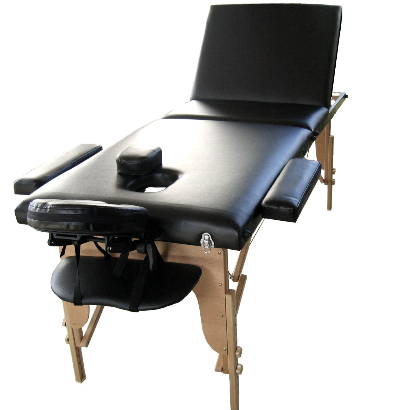
The face cradle extends the length of the table and the arm support hangs below to support clients arms.
This also has the advantage of opening up and relaxing the Trapezius Muscle. (the large muscle extending over the back of the neck and shoulders).
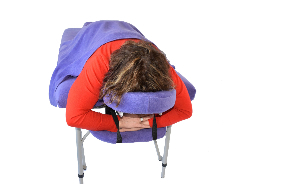
13) Do you want a stationary massage table (non-folding table)?
Stationary Massage Table- New Zealand Made Non-portable Massage Table and Imported Non-PortableHeight Adjustable Massage Table
You would normally require a non-portable table where it will be in a permanent position, and where the table has a very high workload and possibly very heavy massage movements such as sports or Thai Massage. Thai Massage usually requires a wider table for the ease of having the client and practitioner on the table at the same time, and a non-portable table can be easily be constructed to be strong and durable enough for this purpose. These tables can be constructed with steel or wood.
You can test a table by applying firm pressure, sideways and length ways, to be able to "feel" how solid it is. Remember that if it does not feel "solid" to start with, it will only get worse with use.
Some non-portable tables are made to a fixed height, and some are able to be manually height adjusted (the same as a portable table).
Other tables can be electrically or hydraulically height adjustable. These tables, while a lot more expensive, offer the ease of being able to adjust the height multiple times during the treatment without needing to get your client off the table.
Electric and hydraulically height adjustable tables have a lot of pivoting points, and so depending on design and construction can be more or less “solid” feeling. As with all other tables, apply firm pressure, sideways and length ways on the table, to make sure it is going to be strong enough for your requirements. Remember that if it does not feel “solid” to start with, with use, it will only get worse.
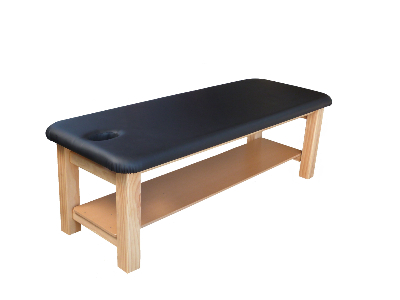
14) Portable Massage Table.
Do you want a portable table? (e.g. folds in half).
Portable massage tables are the most commonly purchased tables because they are easily transported, relatively cheap, and suit a wide variety of uses.
Do you want a portable, aluminium, wooden or steel table?
Aluminium Massage Tables
These can be very lightweight (10-14 kgs). This is one of the reasons for its popularity. Be aware, however, that some cheaper types of aluminium tables are not very durable. This is due to some of the design and construction features.
Aluminium tables usually have a push-button height adjustment. This system is quick and easy to adjust. Be sure, though, that the button system has a good strong “pop out” of the button. If the spring is weak (or becomes weak with use) and the button does not fully pop out, the leg may collapse, causing damage to client and table.
Aluminium tables with the push button height adjustment system, use a telescoping round tube for the legs.
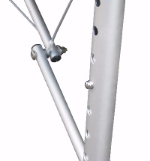
This tube has very small tolerances in the leg, (e.g the gap between the inside of the fixed part of the leg, and the outside of the adjustable part of the leg that telescopes up inside the fixed leg). This means that there is very little “slop” or movement in the legs while the table is being used, while still allowing the leg to move freely up and down to adjust the height. This tube, however, has a relatively thin wall thickness. When the table is adjusted to a high position, (e.g. the inner adjustable part of the leg is fully extended), this allows a certain amount of “flex” (bending) to be felt when the table is in use. While this is not necessarily detrimental to the table, under heavy work, it may be distracting. The lower the table height, the less noticeable the flex is. When you are looking at tables, adjust it to the height you will be working at, and try moving the table top sideways and lengthways to see how stable it is for you. Make sure you put a firm pressure on the table to be able to “feel” how solid it is. Remember that if it does not feel “solid” to start with, with use, it will only get worse.
Other tables use a thicker walled round tube to reduce this “flex”. This tube is not classed as “telescoping”, and generally has a larger tolerance (gap) in the adjustable legs. This results in a more noticeable movement in the legs while under load. Usually, this movement can be lessened with the plastic end cap on the fixed part of the leg, that the adjustable part moves through. The lower the table height, the less noticeable the movement is. When you are looking at tables, adjust it to the height you will be working at, and try moving the table top sideways and length ways to see how stable it is for you. Make sure you put a firm pressure on the table to be able to “feel” how solid it is. Remember that if it does not feel “solid” to start with, with use, it will only get worse.
For your information, our tables are very sturdy under lateral movement.
Be aware of plastic fittings for stay and leg mounts in your table. These can break far easier than wood, aluminium or steel fittings, with the additional worry of whether you are able to purchase these as parts, should they break.
For your information, our massage tables are not constructed with plastic fittings as stay and leg mounts.
Another important point to look at is how “stiff” the end panel/end brace at each end of the table is. These end panels join one leg to the other. There is one set at each end of the table. Some braces are too flexible and bend too much when applying heavy sideways movement to your table. This can put other areas of the table under a lot of stress, and can also make the table feel “wobbly”. I have seen some tables with very thin, flexible braces, rip anchoring rivets out of the table legs. When you are looking at tables, adjust it to the height you will be working at, and try moving the table top sideways and lengthways to see how stable it is for you. Make sure you put a firm pressure on the table to be able to “feel” how solid it is. Remember that if it does not feel “solid” to start with, with use, it will only get worse.

For your information our aluminium tables legs are welded together, which allows our manufacturers to start the end brace low on the main leg, giving maximum strength and stability.
The leg braces that are riveted, have to be riveted high up the main leg, as the rivet will not allow the adjustable leg to move past it on the inside of the main leg. The lower a leg brace is attached to the main leg, the more bracing (stiffening) it will give the table. When you are looking at tables, adjust it to the height you will be working at, and try moving the table top sideways and lengthways to see how stable it is for you. Make sure you put a firm pressure on the table to be able to “feel” how solid it is. Remember that if it does not feel “solid” to start with, it will only get worse with use.
If the table you are looking at has brace systems that clamp around the legs, and then attach to a straight rectangular tube between the legs, I would advise you to be cautious. In my experience of over 24 years of manufacturing, and over 10 years importing massage tables, I have seen many of these types of tables become very “wobbly” with not much work. Again when you are looking at tables, adjust it to the height you will be working at, and try moving the table top sideways and lengthways to see how stable it is for you. Make sure you put a firm pressure on the table to be able to “feel” how solid it is. Remember that if it does not feel “solid” to start with, it will only get worse with use.
For your information, our tables are sturdy under lateral movement.
Steel tables with welded leg braces have no problem and are generally very strong.
Wooden Tables
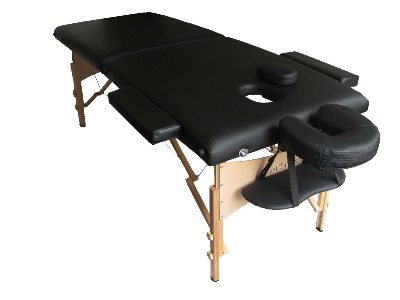
A certain amount of flex (bending) may be noticed in the legs, frame and plywood of a wooden table while under heavy use. This is not necessarily detrimental to the table, as wood can bend a reasonable amount before breaking. Just check that the amount of “flex” is not excessive and that the wood used is straight grained and knot free.
Wood is a “natural”, visually pleasing, renewable product that some therapists prefer, especially when working with the bodies energy system.
The height adjustment system is reasonably easy to use. Just unscrew two plastic leg knobs, pull the adjustable part of the leg off, reposition the adjustable leg back onto the two bolts at the required height, and replace the two leg knobs. Tighten firmly.

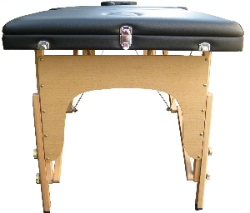
Steel Tables can range in weight from reasonably lightweight 14 kgs to a lot heavier. These tables are generally quite strong, although there are different sizes of steel tube (square and round), used in their construction, also with different wall thicknesses for the tube.
For your information, we do not stock steel massage tables because of some of the issues listed below.
Some steel tables have a push-button height adjustment similar to that on a pair of hospital crutches (e.g. for use with a broken leg). This system is quick and easy to adjust. Be sure, that the button system has a good strong “pop out” of the button. If the spring is weak and the button does not fully pop out, the leg may collapse, causing damage to client and table.
Steel tables that use the push button height adjustment use a telescoping leg to achieve this. Differences in the manufacture of steel tubing versus aluminium tubing mean that steel tube has a lot larger tolerances (gap) in the adjustable legs. This means that there is more movement in the legs while the table is being used. The lower the table height, the less noticeable the movement is. When you are looking at tables, adjust it to the height you will be working at, and try moving the table top sideways and lengthways to see how stable it is for you, to make sure that the amount of movement at the height that you will be using the table, is acceptable for you. Remember that if it does not feel “solid” to start with, with use, it will only get worse.
Other steel tables use the same height adjustment system as a wooden table. The height adjustment system is reasonably easy to use. Just unscrew two plastic leg knobs, pull the adjustable part of the leg off, reposition the adjustable leg back onto the two bolts at the required height, and replace the two leg knobs. Tighten firmly.
There are two disadvantages to this height adjustment system on a steel table as compared to a wooden table. In a wooden table, the inside of the adjustable part of the leg, and the outside of the non-adjustable part of the leg are shaped to fit together in a way that locks them together, so when the grip knobs that hold them together are tightened, they cannot move. With steel, they can only clamp one flat surface against the other flat surface, relying only on the tightness of the grip knobs to prevent movement. If you are using the table for something like sports massage, which has a lot of heavy movements, you may find that further down the track, with normal wear and tear, you are unable to stop movement in the adjustable legs. Remember that if it does not feel “solid” to start with, with use, it will only get worse.
The second disadvantage with this type of steel table versus wood is that when adjusting the height, having undone the plastic grip knobs on the legs, and having pulled the adjustable part of the leg off, you then replace the adjustable part back to the height you require. With wood it is simple, just locate the appropriate two holes, and push on, then replace the two plastic grip knobs. With steel you do the same thing, but, as steel tube is hollow, you have to locate the appropriate two holes, push on, and then you may have to “wiggle” the leg to locate the hole on the inside of the steel adjustable leg part. While this is not a major problem, it can be an inconvenience, and also the holes will tend to wear out, with use, faster than a wooden table.
Be aware of the paint or powder coating finish on the steel components of your table. Most portable steel tables are painted, and with only one coat of black paint. The paint can chip and flake off easily, and patches of surface rust are common. This is not detrimental to the function of the table and is really only a “cosmetic” issue for you to consider.
Also, inquire as to the availability of spare parts, and comprehensive after-sales service, should you need maintenance or repair work. Try a number of different supplier’s tables so you have something to compare each table against. Time spent doing this may be the difference between being happy with your purchase and having regrets.
Summary.
1) There is a huge variety of choice to consider when looking to purchase a massage table. The most important part of choosing is to do your research. Time spent doing this could make the difference between being happy with your purchase and having regrets.
2) You will need to find suppliers that you trust. Many variables in table design and build are not immediately apparent, and you need to know that your supplier has this sorted out for you before you approach them to purchase.
3) Time spent on personal, face to face questioning of suppliers, and hands-on physically testing tables for stability and strength, will go a long way to help you build trust with suppliers that know what they are talking about, and who also have good products. There is no substitute for physically putting your hands on a table, applying firm pressure, and sideways and end to end movements, to "feel" how strong/solid the table is.
4) Investing your money in a "bad" product can be a big waste of time and money.
5) What warranty does each supplier have on their tables and equipment, and what does the warranty cover? Is it a "return to base" warranty? Due to the size of the massage table, it can be expensive to freight the table back to the supplier for a warranty claim.
6) Do the suppliers have a good after-sales service?
Why buy from us? I have had 24 plus years as a massage table manufacturer, 24 plus years as a part or full-time massage therapist, and over 10 years as an importer of massage tables.
We import tables from China, have changed table suppliers a few times and have settled into a good working relationship with our current supplier of over 6 years. We have worked with them to improve their already good product, to one that is amongst the best tables we have seen coming from China.
We have a 2 year back to base warranty on manufacturers faults. Warranty does not cover the foam, vinyl (except for manufacturers faults) or for general wear and tear. We pride ourselves in that we have always bent over backwards to look after our customers on the few occasions that there have been any issues).
Due to my experience in manufacturing massage tables, I know which areas can be potential problems, and how to "fix" this.
We are very happy with our supplier's attention to detail in all areas of manufacture and material sourcing, to produce a table that has proven reliability and durability, and at a reasonable cost. Couple the quality of the product, with our experience, integrity, honesty and commitment to service, and you will be assured of receiving the best possible advice and quality of product from us.
Quite apart from all the general points to consider, there are two key areas that we are different in from other suppliers.
1) We use a good quality 6.2mm hardwood plywood on all our imported portable table models, as opposed to a 5mm (sometimes down to 3.8mm) hardwood plywood (of good or of lesser quality as with some cheaper tables), to guard against "point loading plywood breakages" (as discussed in the above page of "How to Choose A Massage Table").
Having a 6.2mm plywood makes it almost impossible to break the plywood by point loading it.
2) The other area that lets down many cheaper tables, is the foam density (as discussed on the above page of "How To Choose A Massage Table"). On cheaper massage tables, it is common to use lighter density (cheaper) foam. These foams will not last as long as the denser 28kg per cubic meter foam that we use on all our portable tables.
If the foam on your table collapses (does not spring back to its original shape), it will not support a clients weight, and will not provide a comfortable and enjoyable experience. A comfortable and enjoyable experience is probably what they are paying you for, and obviously, you will want them to come back again, and also to tell their friends about your service. This is an important point to consider. (Foam is not usually covered by the manufacturer's warranty)
In addition to having 28kg foam on all our table models, we have increased the thickness from 40mm to 50mm foam on our other portable table models for even more comfort. However, our JTAEL (Aluminium Extra Light) still has the comfortable 40mm foam so we can keep this table as light as possible.
In final conclusion, when buying any product from us, you can trust our integrity, knowledge, experience and fantastic service.
Please do not hesitate to ring us if you have any questions.  098323137
098323137  021 1170279
021 1170279
